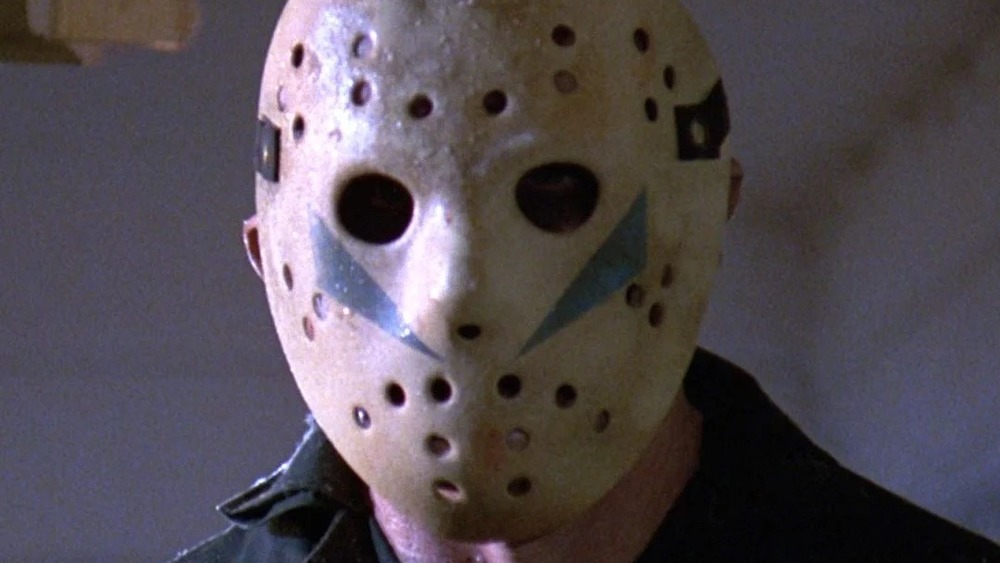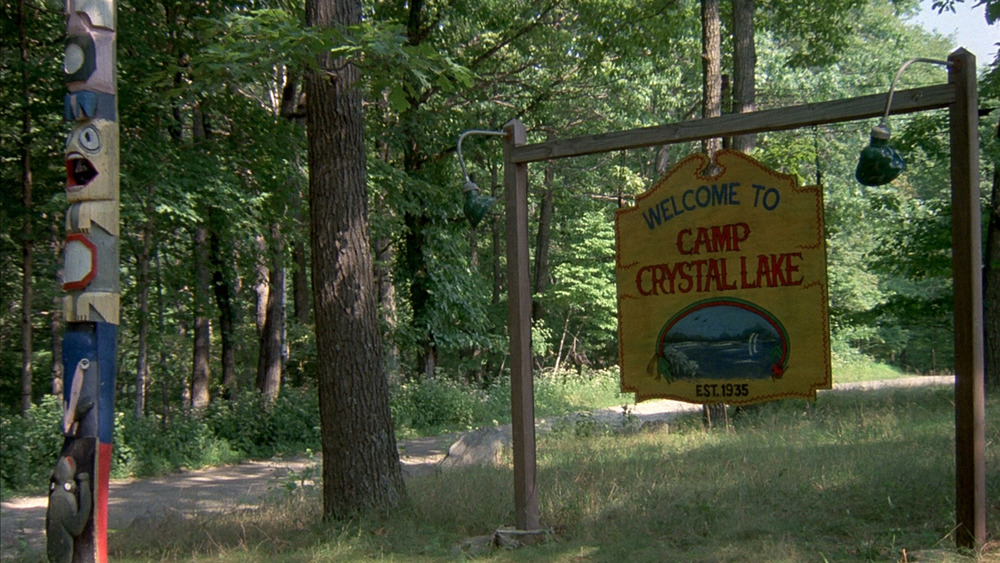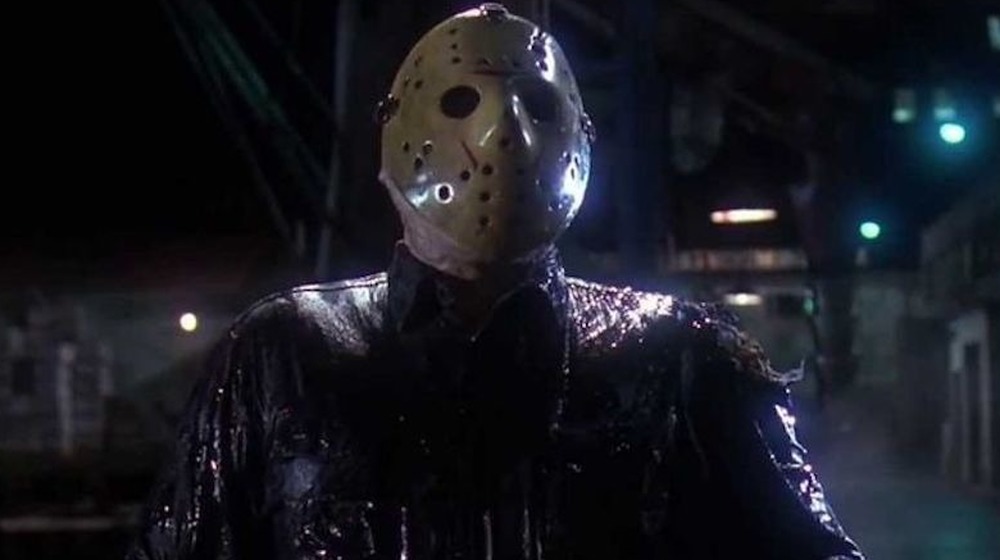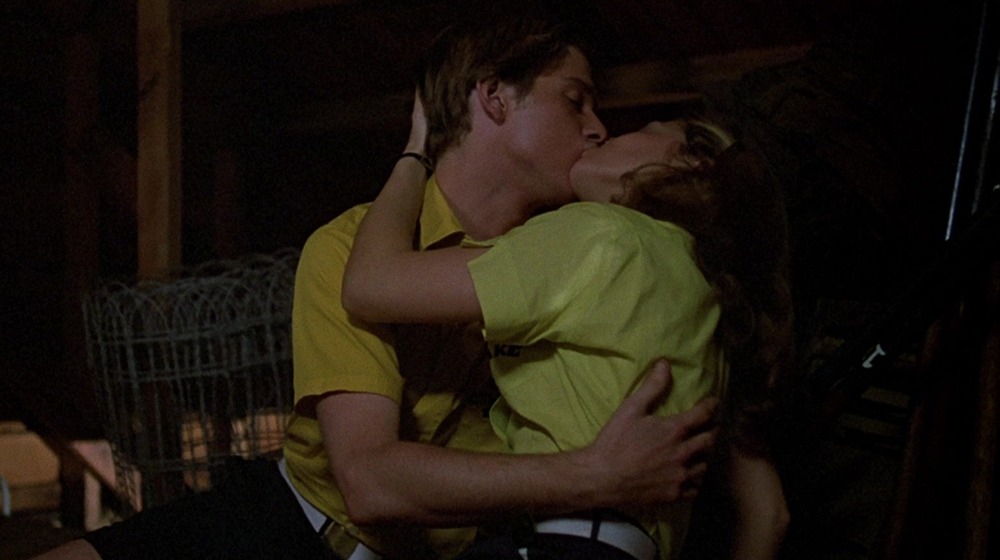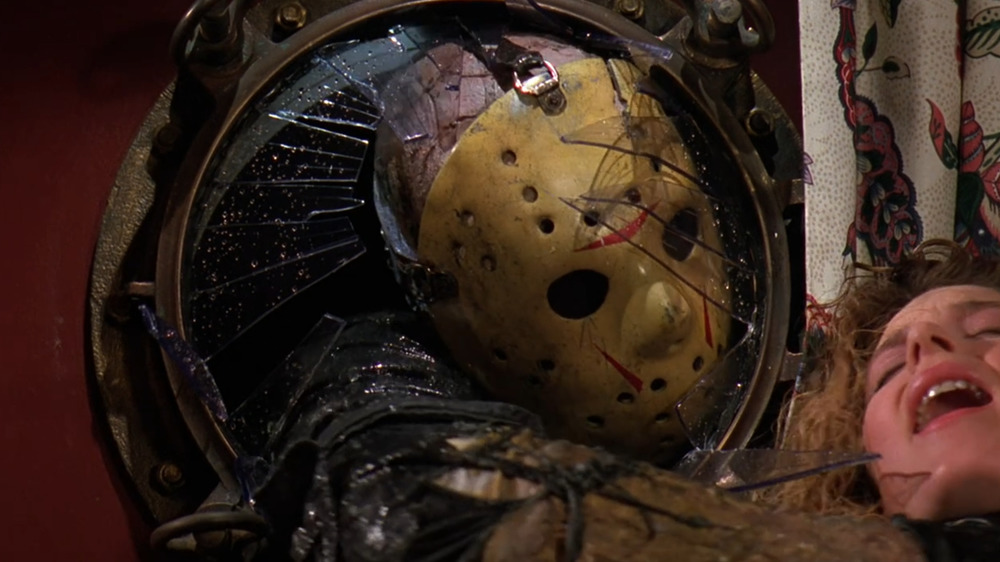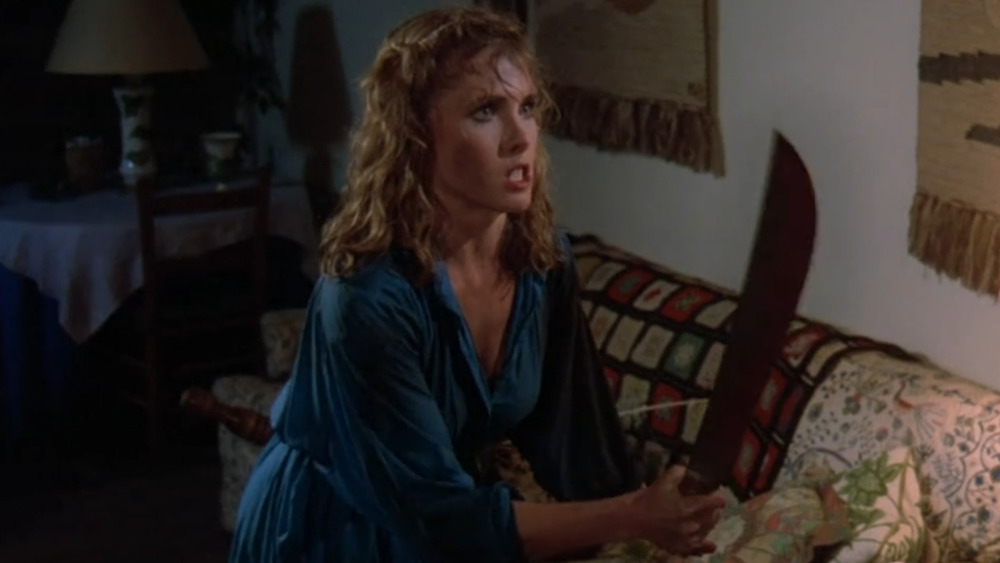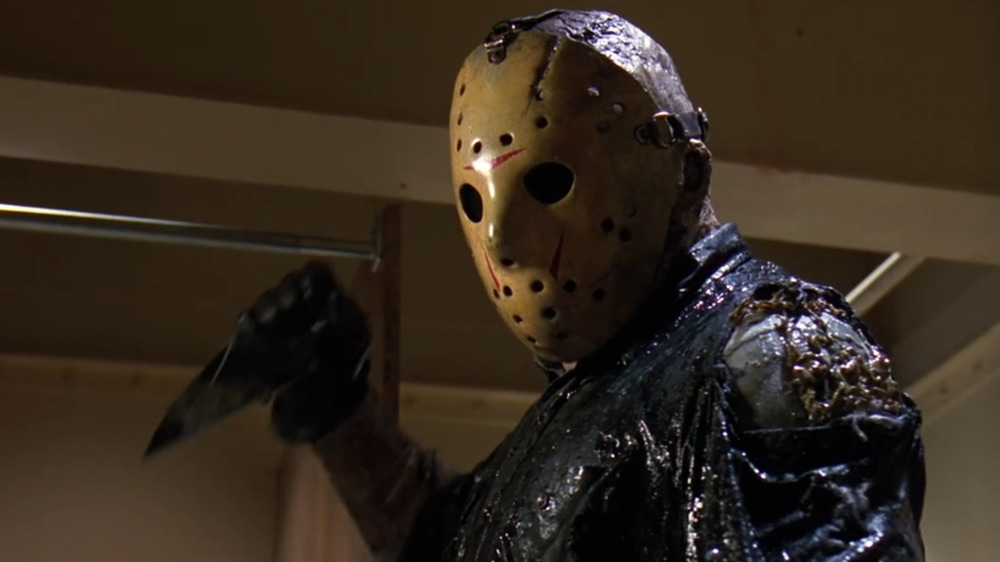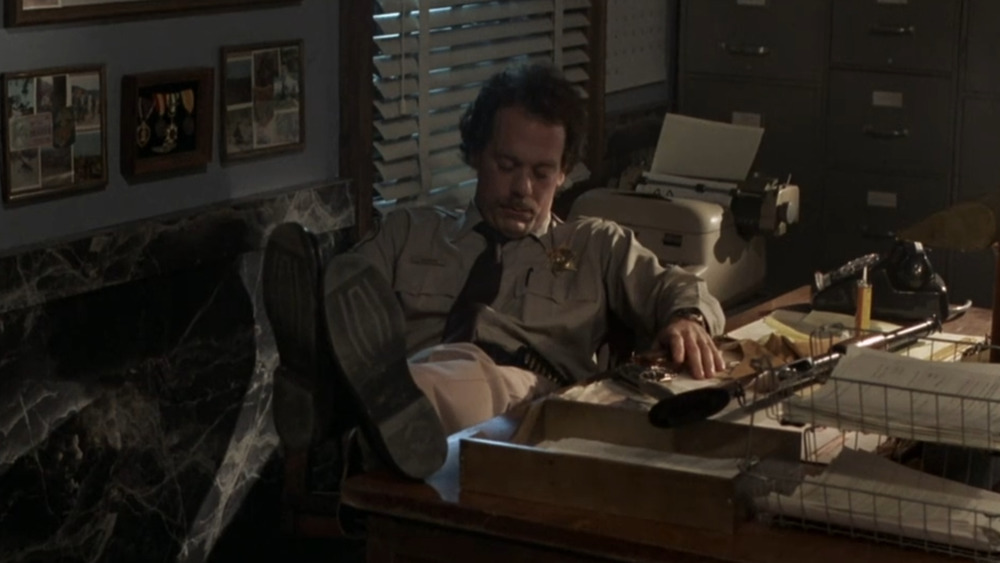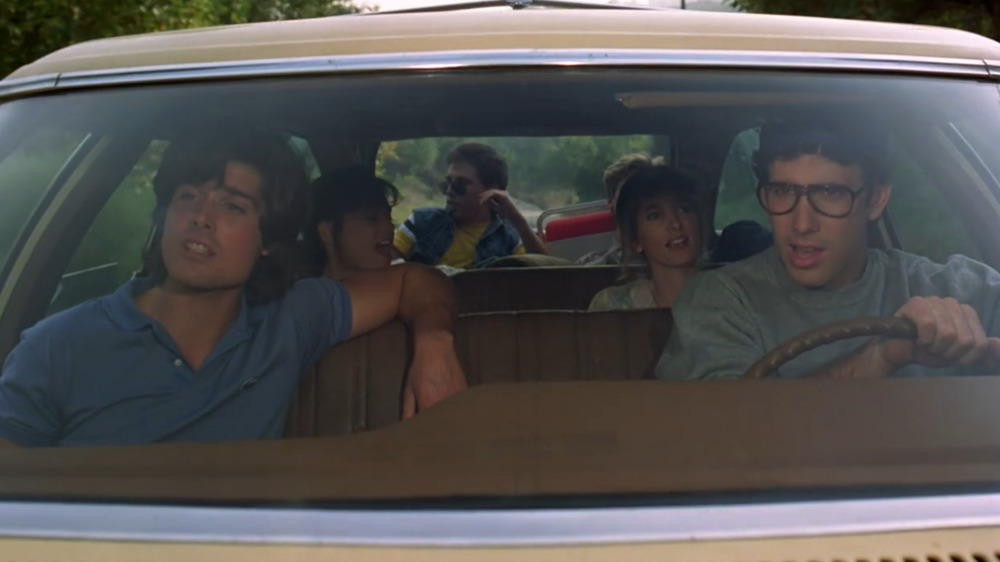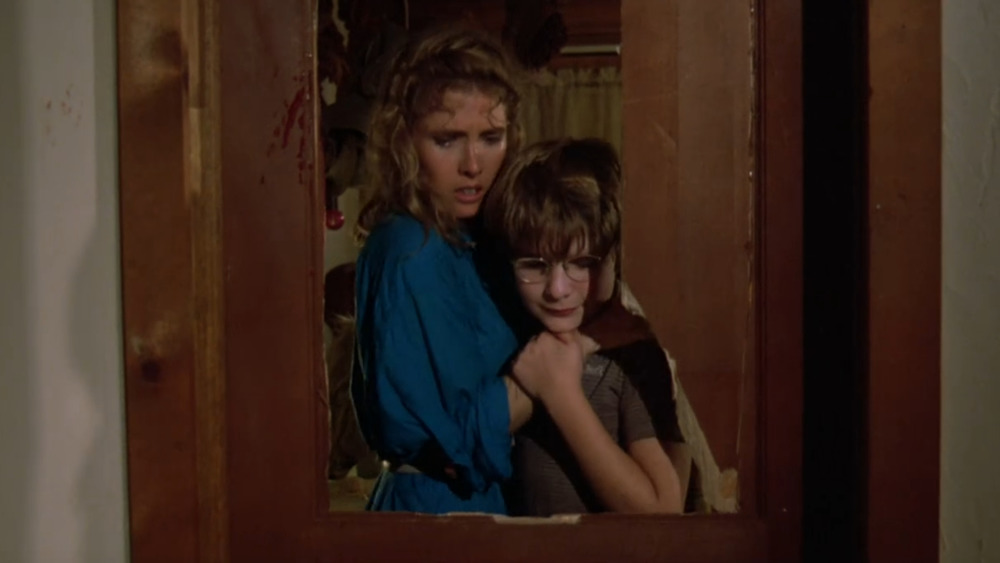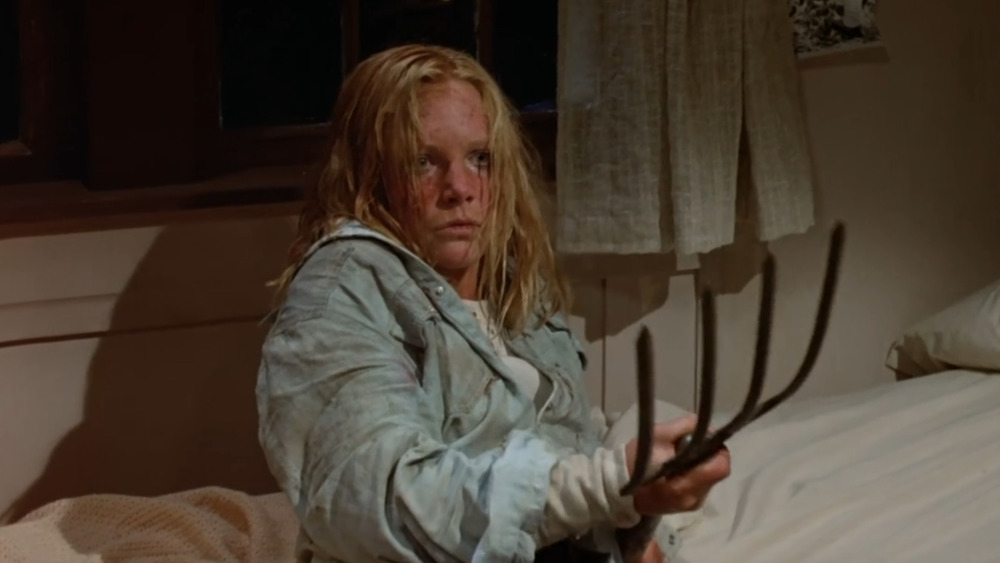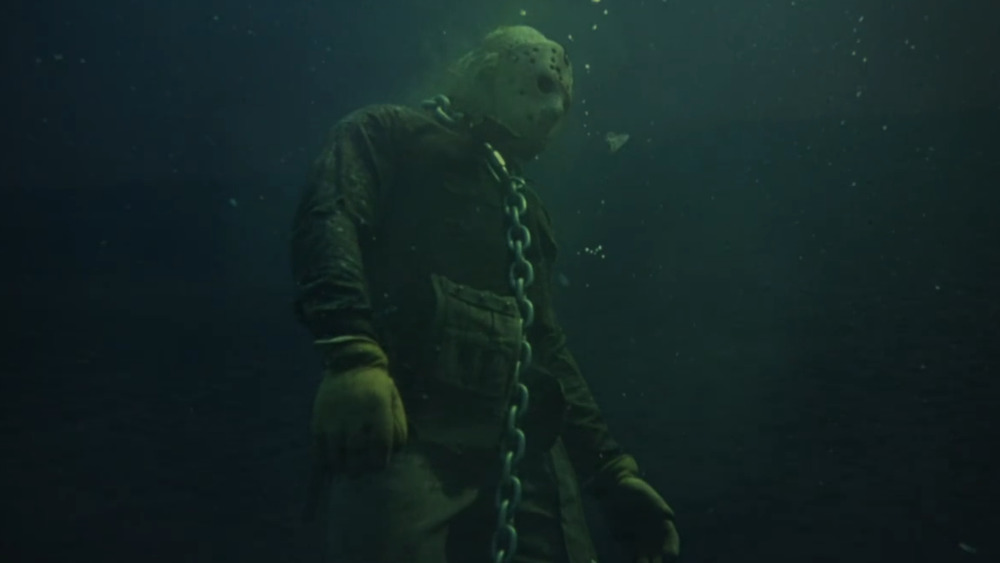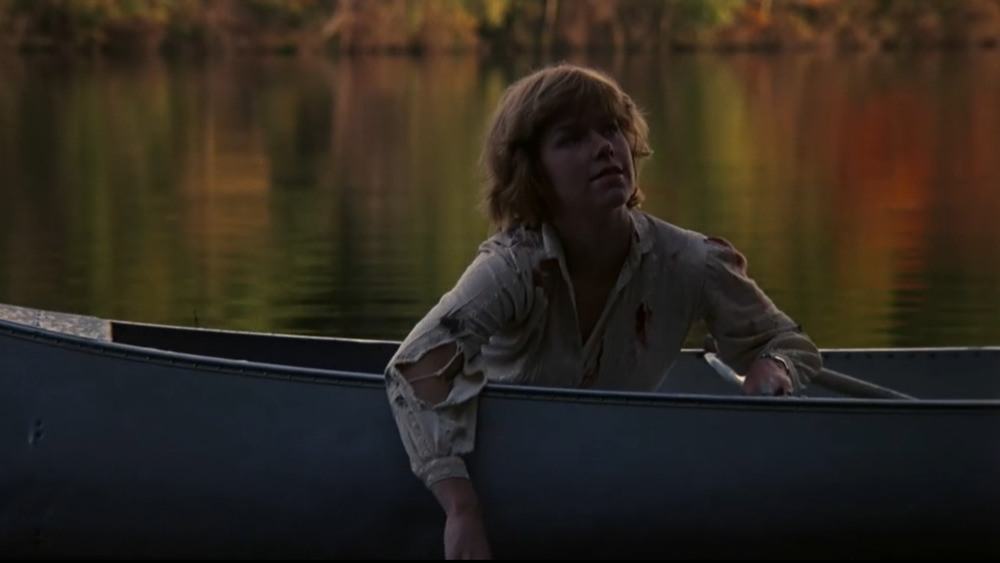Things That Happen In Every Friday The 13th Movie
The Friday the 13th franchise has changed its own formula many, many times. Its iconic image is Jason Voorhees in a hockey mask, but the adult Jason doesn't appear until Part II, and he doesn't don the hockey mask until Part III. Jason doesn't even have a consistent actor, as the great Kane Hodder only plays him in four movies.
As for who Jason is, at one point, his story gets an elaborate mythology behind it, and we find out that the figure we call "Jason" might not be the real Jason Voorhees at all. He also battles with Freddy Krueger and a telekinetic teenager. Plus, he's cryogenically frozen and then awakened in the year 2455, when he goes on a rampage through space and is brought back as a powerful cyborg. It's a lot to take in.
The series obviously has a lot of flexibility, but it also has plenty of constants. However weird the movies get, the more out-there entries still share core traits with the lower-key earlier installments. While killers might come and go, settings might change, and timelines might get jumbled, a Friday film is still a Friday film. And here are the things that happen in every Friday the 13th movie.
(Warning — there are spoilers below.)
We check in with Crystal Lake in every Friday the 13th movie
Jason Voorhees may go to Manhattan — and even to space — but he's a local boy at heart, most comfortable with the woods around his hometown of Crystal Lake. And no matter where the rest of a Friday the 13th movie might be set, the film has to check in on Jason's old stomping grounds. The climax of Freddy vs. Jason even involves hauling Jason back to Crystal Lake in the hopes that it will help give him the upper hand over Freddy Krueger (Robert Englund). This is definitely a franchise that values its home base.
The movies usually take the time to do a little sightseeing around town, too. Crystal Lake locals are a staple of the Friday the 13th films. They pop up to deliver ominous warnings — deranged doomsayer Ralph (Walt Gorney) is the best and most archetypal example — and provide over-the-top local color, such as exuberant chicken-butchering and "Jason burgers" cut to look like hockey masks. While the town's residents are sometimes helpful, they're often just another obstacle ... albeit one Jason inevitably mows down. For example, in Part III, a motorcycle gang harasses some visitors and engages in a little attempted arson. In A New Beginning, a wild mother/son pair get gleeful about the discovery of some murders.
No wonder the town briefly changes its name to Forest Green. Even outside of the string of Voorhees murders, they have a lot to live down.
There's always killer POV cam
Killer POV — where the camera's viewpoint is with the unseen killer, tracking his focus as he watches or approaches a victim — is a staple of the Friday the 13th movies, used to heighten the tension and make us aware that the characters are being watched. In some of the later entries, this camera trick is familiar enough to viewers that the films occasionally use it for fake-outs. In Jason Takes Manhattan, for example, the camera suggests that Jason is making a last-second return, but it turns out that it's just the heroine's dog.
In Jason X, the technique is even used as a joke. We switch to Jason's POV as he approaches two camp counselors in a VR simulation, and then they look directly into the camera and offer him pot and premarital sex.
The best, most effective, and most prolonged use of the killer POV cam is undoubtedly in the first movie, where director Sean Cunningham uses it to conceal the killer's identity. From the way the victims react to the approaching killer — with confusion or surprise rather than fear — we can guess that we're not talking about a hulking man in a hockey mask. But even with that clue, the audiences are still mostly kept in the dark. The revelation that the middle-aged, seemingly harmless Pamela Voorhees (Betsy Palmer) has been behind all the killings remains a great twist, and it's aided by some great camerawork.
The Friday the 13th movies always get rauncy
Getting naked is such a bad idea in the Friday the 13th universe that the FBI deliberately incorporates it into their sting in Jason Goes to Hell, with their undercover agent (Julie Michaels) undressing to lure Jason into the open.
Early on, the fatal consequences of taking your clothes off is at least embedded in the plot. Pamela Voorhees focuses on killing camp counselors she blames for neglecting her son, so it makes a twisted kind of sense that she'd target the ones who are definitely distracted. But even as the series drifts away from the strict revenge focus, sex stays dangerous.
The characters don't even have to actually have sex for it to kill them, either. Thinking about it is enough. The best example of this comes in The Final Chapter, when Ted (Lawrence Monoson) gets stabbed in the head through the projection screen he's been using to watch an old-fashioned stag film. Even sex-free nudity can be enough to doom a character. Poor third-wheel Alexis (Kathryn Atwood) in Jason Goes to Hell only gets a quick skinny-dip in before she's murdered by a coroner possessed by Jason's spirit.
Jason is big into creative body disposal
Jason Voorhees is more of a doer than a thinker, but when it comes to disposing of bodies, he shows a definite cunning.
The usual structure of a Friday the 13th movie involves splitting up the cast so Jason can rack up a high kill count before the characters notice that anything is happening. But once they finally realize what's going on, it's a safe bet that they're going to start stumbling on the deliberately posed bodies of their friends. It's one of the franchise's go-to tricks for heightening the horror. There's not much scarier than having your escape constantly blocked by corpses. In Part II, Jason rigs a body to fall on anyone opening a particular door. In The Final Chapter, he blocks a doorway by nailing a body to the door frame in a crucifixion pose.
These grisly surprises are for the audience as much as they're for the characters, so we don't tend to see Jason set the traps. And on occasion, it's hard to see just how Jason knew the characters were going to be in the right place to witness one of his displays. In Jason Takes Manhattan, for example, that severed head inside the cop car would go to waste if the cop didn't happen to offer the surviving characters a ride. But that's a risk Jason Voorhees is willing to take.
There are plenty of machete kills in the Friday the 13th movies
The machete is Jason's signature weapon, and it's one of the most consistent and iconic aspects of the series.
It's not used exclusively by the villains, either. There's a symbolic power to the terrorized survivors using the machete against their attacker, so it's a popular weapon for the Final Girl — or Final Boy Tommy Jarvis (Corey Feldman) — to wind up wielding in a final attack. In the first movie, Alice (Adrienne King) uses it to behead Mrs. Voorhees, establishing the tradition of heroic machete use. In The Final Chapter, we get to see it slowly and gruesomely split Jason's head in two in a nauseatingly effective scene that reminds us of the gory glory of Tom Savini's effects.
But turning Jason's weapon against him only really works as an ironic reversal if we've seen him use it first, so we see him use it a lot. In Jason Lives, he apparently learns the value of efficiency and uses it for both a double impaling and a triple beheading. Our award for most memorable machete death has to go to poor Andy (Jeffrey Rogers) in Part III, whose exuberant post-sex handstand results in him getting chopped in two vertically, from groin to skull. Ouch.
There's at least one non-machete kill
The Friday the 13th franchise believes in creative horror deaths, so it keeps its murder methods grisly and unpredictable. It's not a Friday the 13th movie if the killer doesn't use their imagination and their resources.
Sometimes it all comes down to brute strength. Jason is perfectly capable of crushing someone's skull between his bare hands. In fact, he does it twice, with the original 3D effects in Part III making the victim's eyeballs pop out at the audience. Sharp objects are also popular, with an arrow through the throat (Friday the 13th), a knitting needle through the skull (Part III), and a sauna rock through the chest (Jason Takes Manhattan). And he can get creative. In Jason X, he dunks a victim in liquid nitrogen and then smashes her frozen head against the counter.
But some of the most unusual and graphic kills in the franchise don't belong to Jason at all. They're the work of A New Beginning's Roy (Dick Wieand), a paramedic who uses copycat-style Jason killings to mask his murderous rampage of revenge on his dead son's behalf. Roy stabs one man through the mouth with a burning road flare, puts a woman's eyes out with pruning shears, and crushes another man's head via a gruesome use of physics involving a tree and a belt. Jason might eventually become an immortal and inhuman embodiment of evil, but he can still be trumped by ordinary human sadism.
The authorities are no help at all
In the Friday the 13th franchise, no one is coming to help you. Or, if they are, they're going to immediately screw it up.
The biggest problem with the Crystal Lake police is that they can't accept that they have a supernatural killer on their hands. The most prominent role any cop plays is in Jason Lives, where Sheriff Mike Garris (David Kagen) threatens a grown-up Tommy Jarvis (Thomas "Thom" Mathews), shoves him in a cell, and tries to escort him out of town — all to keep him from talking about Jason Voorhees and stirring the legend up again. Notably, the one time a cop is quick to name Jason as the killer, in A New Beginning, he's actually wrong.
No other authority figures consistently come out looking great, either. The principal in Jason Takes Manhattan (Peter Mark Richman) is snide, spiteful, unhelpful, and — as a flashback reveals — abusive, having once almost drowned his niece in a heartless attempt to "teach" her to swim. And the journalist in Jason Goes to Hell (Steven Culp) is sleazy, opportunistic, and criminal.
At least the FBI's sting operation briefly seems to work, taking Jason down in a hail of gunfire ... until it turns out this just makes his evil spirit hop around from person to person. Apparently, defeating Jason Voorhees is a task best left to the amateurs.
Someone has to be from out of town
This is one of the simplest and most obvious rules of a Friday the 13th movie. Basically, having an outsider in the cast is a good excuse to include the franchise's backstory, giving any new viewers the info they might need. The legend of Jason and Pamela Voorhees gets told as a campfire story in Part II, for example, and in The New Blood, Tina (Lar Park-Lincoln) finds newspaper clippings about the killings.
The series often likes to use former Crystal Lake residents in this role, especially if they haven't lived there since they were kids. Tina falls into this category, as does Tommy Jarvis in both A New Beginning (John Shepherd) and Jason Lives. This in-between status gives them Crystal Lake-related childhood trauma to overcome while still positioning them as outsiders who might be dismissed or ignored.
A subtler benefit of including characters from outside Crystal Lake is the comedic value of bringing them face to face with an undead, machete-wielding killer. Jason Takes Manhattan makes the best use of this. When Jason casually destroys the stereo belonging to a group of New York "tough guys," they gather up their chains and knives and get ready to square off against him. Jason just turns around and lifts his mask, revealing the rotting face underneath. The leader abruptly and understandably changes his mind, saying, "It's cool, man. It's cool."
The settings get trashed
We pity the set designers of a Friday the 13th film. Their work never gets to survive for very long.
Jason may like killing camp counselors and Crystal Lake residents, but his real passion seems to be property damage. After all, it shows there's no safe place to hide. He especially relishes breaking windows, whether he's exploding through them to grab someone or hurling a hapless victim to their death. Sometimes all this window-breaking also ties into his penchant for showy corpse displays. In Part III, when a terrified girl cries out for her boyfriend, Jason mocks her by "helpfully" throwing his body through the window.
Windows may be the most consistent collateral damage in the franchise, but no home fixture is safe. Jason destroys a cabin's shower in The Final Chapter and a mirror in Jason Takes Manhattan. He crashes through a staircase in The New Blood and up through a dock in the 2009 remake. Settings are also sometimes destroyed by people fighting back, which is why The New Blood features a house that explodes in a gasoline fire.
All of this lends a little humor to Jason's death in Jason Takes Manhattan, where he drowns in the toxic waste that the city apparently floods through the sewers every night. It's a little ridiculous, sure. But it's about time one of the places he's rampaged through took its revenge.
The Final Girl always survives in the Friday the 13th movies
Friday the 13th movies always have what slasher fans call a Final Girl. The term was coined by Carol J. Clover in her book Men, Women, and Chain Saws. In essence, the Final Girl is the female character who makes it to the end in part because she's the "viewpoint" character for the movie. Final Girls are usually — though not always — tomboyish, introverts, and virgins.
The Friday the 13th franchise helped establish the Final Girl trope. In each film, a central female character makes it to the end. She defeats or helps defeat the killer and "lives to tell the tale," as Clover puts it. She can be jeopardized in her last scene — this happens in both A New Beginning and the 2009 remake — but her death can't be conclusive.
The series also plays with Final Girl expectations. Alice survives the first movie only to die at the beginning of the second. Her victory over Mrs. Voorhees doesn't protect her in the long run, it just motivates Jason to take revenge. And notably, the franchise's longest-running "Final Girl" is actually a boy, Tommy Jarvis. But while the rules are flexible, they're still rules. Even the entries that focus on Tommy still don't let him make it to the end alone. In each case, he's paired with a more traditional (and literal) Final Girl.
The killer is dead (or undead) at the end
In the Friday the 13th franchise, the killer will always be back in one form or another, but each individual movie has to get a satisfying ending from the bad guy's defeat and death.
With Mrs. Voorhees and Roy, the deaths are permanent. However, in Jason's case, at least after a few fake-out deaths in his first few installments, it gets more complicated. After all, he eventually wind ups obviously undead. When he's resurrected in Jason Lives, he's already a worm-eaten corpse.
It's hard to say what would kill him again at that point, but each movie manages to give him some kind of (temporarily) conclusive downfall. At the end of Jason Lives, he's simply chained up at the bottom of the lake, still conscious but unable to escape. Since he's already dead, he just has to be "buried." This sets the pattern. If characters can get Jason back to a grave (ideally a watery one) he loses. And he always has to lose.
Even in Freddy vs. Jason, while he eventually gets the upper hand on Freddy Krueger, he still sinks down into the lake first to give the main characters their victory. The remake is the only movie that might have him surging back to life at the very end, and that's just formally welcoming him to his new undead life.
Friday the 13th endings are more haunting than triumphant
Friday the 13th movies always have survivors, but they're shaken by what they've been through. Sometimes they're even destroyed by it. Parts II and III end with the Final Girls being taken away, obviously traumatized and confused, and the fourth and fifth installments get even darker. The ending of The Final Chapter implies that Tommy Jarvis is corrupted by killing Jason, and violence is now a part of him. This is reprised in A New Beginning, when Tommy dons a hockey mask and seems ready to kill the Final Girl.
Even the happier endings acknowledge the darkness surrounding them. The characters often need paramedics and a ride to the hospital, for one thing. And they're always mourning dead friends or family members. The franchise can get pretty goofy at times, but when the credits to roll, it likes to go with a more somber mood to remind viewers of the stakes. There's no better example than the first film, where an undead Jason rises from the lake and tries to pull Alice underwater. However, the police think she dreamed it since they didn't find a body. But this bit of logic can't reassure Alice. "Then," she says, "he's still there." It's an unsettling, chilling line and one of the best moments in the series.
